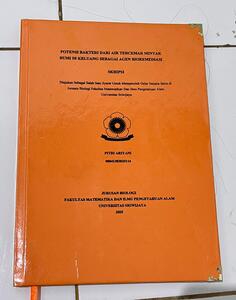ARIYANI, PITRI and Nurnawati, Elisa (2025) POTENSI BAKTERI DARI AIR TERCEMAR MINYAK BUMI DI KELUANG SEBAGAI AGEN BIOREMEDIASI. Undergraduate thesis, Sriwijaya University.
![[thumbnail of RAMA_46201_08041382025114_cov.jpeg]](https://repository.unsri.ac.id/181356/1.hassmallThumbnailVersion/RAMA_46201_08041382025114_cov.jpeg)  Preview |
Image
RAMA_46201_08041382025114_cov.jpeg - Cover Image Available under License Creative Commons Public Domain Dedication. Download (538kB) | Preview |
|
Text
RAMA_46201_08041382025114.pdf - Accepted Version Restricted to Repository staff only Available under License Creative Commons Public Domain Dedication. Download (2MB) | Request a copy |
|
|
Text
RAMA_46201_08041382025114_TURNITIN.pdf - Accepted Version Restricted to Repository staff only Available under License Creative Commons Public Domain Dedication. Download (12MB) | Request a copy |
|
|
Text
RAMA_46201_08041382025114_0027047502_01_front_ref.pdf - Accepted Version Available under License Creative Commons Public Domain Dedication. Download (1MB) |
|
|
Text
RAMA_46201_08041382025114_0027047502_02.pdf - Accepted Version Restricted to Repository staff only Available under License Creative Commons Public Domain Dedication. Download (373kB) | Request a copy |
|
|
Text
RAMA_46201 _08041382025114_0027047502_03.pdf - Accepted Version Restricted to Repository staff only Available under License Creative Commons Public Domain Dedication. Download (293kB) | Request a copy |
|
|
Text
RAMA_ 46201_08041382025114_0027047502_04.pdf - Accepted Version Restricted to Repository staff only Available under License Creative Commons Public Domain Dedication. Download (524kB) | Request a copy |
|
|
Text
RAMA_46201_08041382025114_0027047502_05.pdf - Accepted Version Restricted to Repository staff only Available under License Creative Commons Public Domain Dedication. Download (162kB) | Request a copy |
|
|
Text
RAMA_46201_08041382025114_0027047502_06_Ref.pdf - Accepted Version Restricted to Repository staff only Available under License Creative Commons Public Domain Dedication. Download (212kB) | Request a copy |
|
|
Text
RAMA_46201_08041382025114_0027047502_07_Lamp.pdf - Accepted Version Restricted to Repository staff only Available under License Creative Commons Public Domain Dedication. Download (1MB) | Request a copy |
Abstract
Petroleum pollution is a serious environmental problem that requires effective and sustainable solutions. Bioremediation, which utilizes the ability of microorganisms to degrade contaminants, offers an ecological approach to addressing hydrocarbon pollution. This study aims to isolate and identify hydrocarbon-degrading bacteria from petroleum-contaminated water in the Keluang area, and evaluate their potential as bioremediation agents. The methods used include sampling of contaminated water, bacterial isolation, stage I and II selection based on their ability to degrade petroleum, calculating TPC (Total Plate Count), and characterizing the morphology and physiology of selected bacterial isolates, including Gram staining and endospore testing. The results of the study indicate the successful isolation of bacteria with hydrocarbon-degrading abilities. Various isolates were shown to be able to grow and reduce petroleum contaminants in the media, indicating degrading activity.Further characterization identified bacterial traits that support their role in bioremediation, such as morphological and physiological characteristics typical of hydrocarbon-degrading bacteria. Oilcontaminated water in Keluang harbors bacteria with significant potential as bioremediation agents for more environmentally friendly recovery strategies. Each isolate identified as a hydrocarbonoclastic bacterium had the potential to degrade total petroleum hydrocarbons (TPH), with biodegradation rates of 27.71% for 14A, 37.14% for 15A, 64.28% for 15B, and 20.57% for 16A. Identification results showed that bacterial isolate I4A was similar to the genus Sporolobacillus, isolate I5A was similar to the genus Klebsiela, isolate I5B was similar to the genus Citrobacter, and isolate I6A was similar to the genus Lactobacillus. Keywords: Petroleum, Pollution, Bioremediation, Hydrocarbon-degrading Pencemaran minyak bumi menjadi masalah lingkungan serius yang membutuhkan solusi efektif dan berkelanjutan. Bioremediasi, yang memanfaatkan kemampuan mikroorganisme mendegradasi kontaminan, menawarkan pendekatan ekologis untuk mengatasi pencemaran hidrokarbon. Penelitian ini bertujuan mengisolasi dan mengidentifikasi bakteri pendegradasi hidrokarbon dari air yang tercemar minyak bumi di daerah Keluang, serta mengevaluasi potensi bakteri tersebut sebagai agen bioremediasi. Metode yang digunakan meliputi pengambilan sampel air tercemar, isolasi bakteri, seleksi tahap I dan II berdasarkan kemampuan mendegradasi minyak bumi, perhitungan TPC (Total Plate Count), serta karakterisasi morfologi dan fisiologi isolat bakteri terpilih, termasuk pewarnaan Gram dan uji endospora. Hasil penelitian menunjukkan keberhasilan isolasi bakteri dengan kemampuan mendegradasi hidrokarbon. Berbagai isolat terbukti mampu tumbuh dan mengurangi kontaminan minyak bumi dalam media, yang mengindikasikan aktivitas pendegradasian. Karakterisasi lebih lanjut mengidentifikasi sifat-sifat bakteri yang mendukung peran mereka dalam bioremediasi, seperti karakteristik morfologi dan fisiologi yang khas untuk bakteri pendegradasi hidrokarbon. Air tercemar minyak bumi di Keluang mengandung bakteri yang memiliki potensi signifikan sebagai agen bioremediasi untuk strategi pemulihan lingkungan yang lebih ramah. Masing-masing isolat yang terindikasi bakteri hidrokarbonoklastik memiliki potensi menurunkan total petroleum hidrokarbon (TPH) dengan persentase biodegradasi meliputi 14A sebesar 27,71%,15A sebesar 37,14%, isolat 15B sebesar 64,28%, dan 16A sebesar 20,57%. Hasil identifikasi isolat bakteri I4A memiliki kemiripan dengan genus Sporolobacillus, isolat I5A memiliki kemiripan dengan genus Klebsiela, isolate I5B memiliki kemiripan dengan genus Citrobacter, dan isolat I6A memiliki kemiripan dengan genus Lactobacillus. Kata Kunci : Minyak bumi, Pencemaran, Bioremediasi, Bakteri pendegradasi hidrokarbon, Keluang. bacteria, Keluang.
| Item Type: | Thesis (Undergraduate) |
|---|---|
| Uncontrolled Keywords: | minyak bumi, keluang, bakteri |
| Subjects: | Q Science > QR Microbiology > QR75-99.5 Bacteria |
| Divisions: | 08-Faculty of Mathematics and Natural Science > 46201-Biology (S1) |
| Depositing User: | Pitri Ariyani |
| Date Deposited: | 29 Jul 2025 03:03 |
| Last Modified: | 29 Jul 2025 03:03 |
| URI: | http://repository.unsri.ac.id/id/eprint/181356 |
Actions (login required)
 |
View Item |
